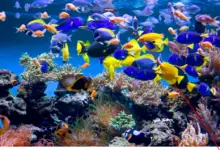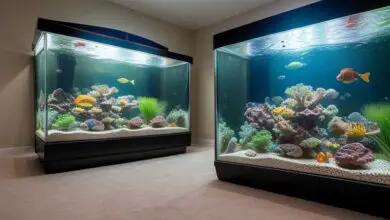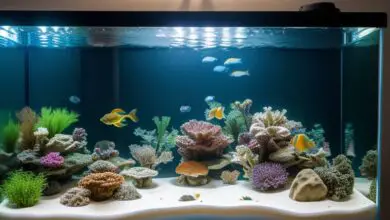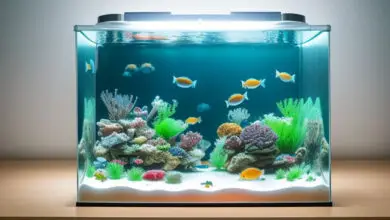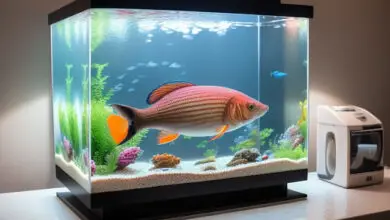Environmentally Safe Cleaning Products for Aquariums

Keeping your home aquarium sparkling clean doesn’t have to harm the environment. With the rise in popularity of organic, non-toxic cleaners, now you can find eco-friendly solutions for all your fish tank cleaning needs. From controlling algae to conditioning water, natural aquarium products get the job done without introducing harsh chemicals into our waterways.
In this blog, we’ll explore a wide variety of environmentally safe aquarium cleaning products to use for spotless, healthy habitats. You’ll learn options for clearing pesky algae, wiping clean glass, purifying water, grooming plants and more using earth-friendly formulas. We’ll also tackle some frequently asked questions about green cleaners for fish tanks.
Join us as we dive into maintaining crystal clear water in your home aquarium, in harmony with the planet!
The Importance of Using Environmentally Safe Aquarium Products
Part of being a responsible aquarist includes keeping fish, plants and tank decor sparkling clean on a regular basis. However, many conventional cleaning chemicals contain dangerous ingredients like chlorine, ammonia and phosphates that get released into the water, severely compromising aquatic life. What’s worse, these toxic solutions end up draining into environmental waters during water changes or tank breakdowns, polluting fragile ecosystems.
This makes choosing specially formulated, non-toxic products essential for keeping home aquariums and wild habitats pristine yet safe for inhabitants. Eco-friendly aquarium cleaners avoid hazardous chemicals in favor of plant-based, biodegradable ingredients that break down quickly without disturbing delicate biological balances. Using these natural solutions protects species living in your aquarium as well as wildlife dependent on streams, wetlands and oceans.
When sourcing green aquarium cleaners, prioritize options certified cruelty-free, non-GMO and derived from sustainable practices. Packaging also matters – support companies utilizing recyclable containers made from eco-conscious materials. Every small choice makes a difference! Now let’s explore all natural solutions for keeping algae under control in your fresh or saltwater habitat.
Natural Algae Control Solutions for Aquarium Glass & Decor
Managing algae growth is an integral part of maintaining any healthy aquarium. However, harsh chemical algaecides commonly used to control blooms contain copper, phenols and formaldehyde – extremely toxic compounds that build up, causing long term harm.
Thankfully, several environmentally safe products groom aquarium glass, ornaments and plant leaves using gentle, non-toxic formulas:
Barley Straw Extract – Derived from natural barley fibers, barley straw inhibits algae spore growth. Safe for fish, plants and biological filtration.
Hydrogen Peroxide – Low concentration dilutions of hydrogen peroxide actively combats green hair, black beard and spot algae without jeopardizing aquatic life when used properly. Rinse well.
Vinegar Wash – White distilled vinegar makes an effective spot treatment for scrubbing away stubborn algae from decor. Rinse thoroughly before returning items to the tank.
Diatomaceous Earth – Sprinkling this powderized skeletal clay on affected areas smothers and kills common blue-green and dark red algae varieties. Rinse residue after an hour.
UV Sterilizers – UV clarifiers expose free-floating algae spores to ultraviolet light, disrupting reproductive cycles. Green clean technology!
With regular use, these all-natural alternatives substantially control algae growth sans chemicals. Next let’s review eco-friendly glass and equipment cleaners.
Eco-Friendly Glass & Equipment Cleaning Options
Over time, mineral deposits, residue and water spots accumulate on interior glass as well as filtration gear. While crucial for visibility and functionality, traditional cleaning solutions often contain soaps, fragrances and solvents that stress fish. Take the non-toxic route by using one of these earth-friendly aquarium glass and equipment cleaners instead:
Non-Toxic Homemade Formula Options
Vinegar-Based Glass Cleaner – Mix 1 part vinegar with 2 parts water and add several drops of lemon juice for streak-free shine without chemicals. Spray on and wipe dry with newspaper or reusable cloth.
Citrus Salt Scrub – For heavy calcium deposits, gently scrub with half sliced lemon dipped in salt, rinse and wipe clean. The acid tackles buildup while salt granules lightly abrade.
Baking Soda Solution – Make a paste of 3 parts baking soda to 1 part water. Apply paste to equipment, let sit 5 minutes before scrubbing and rinsing clean. Baking soda alkalinity dissolves residue without additives.
Safe for Sensitive Aquatic Life
Unlike commercial cleaners, these non-toxic homemade solutions won’t harm fish or plants when accidentally introduced into the tank water during cleaning sessions or water changes. Made from pantry staples, they get the job done without risky chemical fumes either.
Eco-Friendly Packaging Choices
Whipping up your own aquarium glass and gear cleaners means zero plastic waste compared to store-bought alternatives. Use reusable spray bottles for vinegar mixes and store baking soda/salt/lemon scrubs in glass jars with biscuit cutters for easy use. Being eco-conscious has never been simpler!
Now that we’ve covered how to clear algae and scrub tanks/equipment let’s explore options for conditioning water without toxins.
Non-Toxic Water Conditioners & Supplements
Tap water contains heavy metals, chloramines and chlorine that threaten sensitive fish, shrimp and snails. Traditionally, chemical water conditioners neutralize these toxins but leave behind their own problematic compounds. All-natural alternatives like these nurture aquatic life using pure formulations instead:
Non-Toxic Water Conditioners
Vitamin C (Ascorbic Acid) Powder – A pinch of vitamin C powder instantly removes chlorine and chloramines from tap water by converting the compounds into harmless chloride ions during dechlorination.
Sodium Thiosulfate – This gentle salt neutralizes both chlorine and ammonia during water changes and new tank set-ups. Rapidly makes tap water safe for fish without side effects.
Synergistic Blends – Some brands combine thiosulfate with botanical extracts like rooibos, aloe and acai for enhanced anti-oxidant and slime coat protection during dechlorination.
Chemical-Free Supplements
In addition to making tap water safe, eco-friendly supplements nourish fish and manage issues like hardness without toxins:
Indian Almond Leaves – Replicating blackwater conditions, IALs release tannins and beneficial botanicals into the water to enhance flavor, color and nutrition. Also aids fish immunity and adaptation during acclimation.
Mineral Chips – Clay-based mineral balls infuse hardness elements like calcium and magnesium slowly over time to build appropriate mineral levels for species needing alkaline water.
Driftwood Extract – Concentrated botanicals and organic acids from spider wood, manzanita and mopani leach tannins into the tank water, lowering pH naturally while encouraging natural behaviors.
Sustainable Water Conditioning
Beyond ingredients, many all-natural water supplements demonstrate serious eco-credentials through sustainable harvesting, non-GMO verification, reusable packaging and more. Doing right by the planet and your aquatic pets!
Up next we’ll review non-toxic solutions for keeping gravel pristine during tank maintenance.
Eco-Friendly Gravel Cleaners & Clarifiers
As debris accumulates, routinely vacuuming aquarium gravel helps maintain sanitary tank conditions. However most siphon-style cleaners leach airborne toxins and plasticizers into the water. Greener options like these prevent questionable chemicals from entering fragile aquatic environments:
Air-Powered Pumps – These ingenious cleaners use only the power of compressed air to siphon gunk during gravel washing. No filters, cartridges or tubing to leak chemicals or clog up.
Sand Cleaner Fish – Enjoy natural substrate cleaning by keeping solitary bottom feeding fish like cory cats, loaches or stingrays that continuously sift through gravel for food.
Gravel Gardens – Invite aquatic plants like dwarf hairgrass, mosses and carpeting plants with extensive root networks to grown amongst gravel. Roots naturally filter and block debris.
Clean Up Crews – Recruit algae eating snails, shrimp and other scavengers to tackle bits of leftover fish food, plant matter and fish waste debris before it sinks and rots in substrate.
Water Clarifiers – All-natural clarifying supplements like chitosan or peat granules coagulate tiny suspended particles so gravel vacuuming siphons more gunk up during cleanings without altering water chemistry long term.
Now that we know some excellent alternatives to toxic gravel washing solutions, let’s turn our attention to natural filter media.
Organic Filter Media Choices
Healthy biological filtration relies on porous media like sponges, bioballs and ceramic rings to culture massive colonies of beneficial bacteria. These microorganisms process ammonia and nitrates to keep water safe. While crucial, some filter media options impact sustainability:
Sustainable Natural Media – Instead of plastic bio balls, opt for fully biodegradable solutions like coconut shell carbon, lava rock shards or sustainable wood. These organic media alternatives leach beneficial tannins and minerals to bootstrap biological filtration and naturally soften water.
Reusable Media – Skip chemical filter cartridges swapped out monthly. Reusable sponges, mesh media bags and porous stones last for years with simple rinsing when clogged. Significantly less plastic waste! Even better, repurpose mature media between tank upgrades to virtually instant cycle new systems with robust colonies pre-established.
Moss Walls & Balls – Fluffy mosses like java, christmas, peacock and phoenix moss naturally uptake nitrogen compounds and provide ample surface area for aerobic bacteria to colonize when attached to filters, rocks or mesh forms.
No matter which eco-filter media above you choose, be sure to size your filter properly and clean monthly to prevent flow issues for maximum sustainability. Up next we’ll explore maintaining live aquarium plants safely.
Natural Aquarium Plant Products
Introducing live freshwater plants brings their own set of fertilization and care requirements – but choosing specifically organic formulations protects habitats:
Organic Root Tabs – Slow release plant food spikes made from natural marine compounds, vegetable extracts and rich earthworm castings nourish roots without dumping synthetic nitrates into the water column for uptake by algae.
Liquid Seaweed Fertilizers – Stimulate rapid plant growth with gentle liquid kelp and seaweed based foliar feeds. Boosts chlorophyll and protein production without spiking nitrogen.
Mineral Growth Supplements – Ionic compounds like iron, potassium, magnesium and more get perfectly chelated for easy uptake. Balances aquarium mineral levels too.
All Natural Co2 Methods – Skip complicated equipment and risky chemical mixes by using simple yeast-based DIY Co2 kits. Or give plants their carbon dioxide fix by grouping fast growing stems with surface floating plants in balance.
Sustainable Tools – Upgrade typical plastic plant trimming tools for stainless steel variants and sustainable bamboo plant weights that add charm while keeping valuables properly anchored in place.
Ensuring thriving plants help maintain pristine water quality and provide natural enrichment. But don’t forget suitable water testing and equipment maintenance too!
Eco-Friendly Equipment Maintenance Products
Over time gunk builds up on air pumps, power heads and filtration parts which can leach paints and chemicals when left unaddressed. Balance the ecosystem with natural cleaners better for your hands and the environment overall:
Citrus Acid Scrubs – For simple gunk removal from equipment, use salt sprinkled on lemon, lime or orange halves to dissolve mineral build up. Avoid cleaning motors this way. Rinse well after treatment before returning gadgetry to the tank.
Baking Soda Soaks – Dissolve 3 parts baking soda per 1 part hot water for an alkaline bath to lift grease and oils from dirty pump parts and tubing during deep cleanings. Rinse all residual solution off fully afterwards.
White Vinegar Rinses – Mild acid white vinegar shines glass on old aquariums or showcases. Also removes stubborn hard water stains from stainless steel tools and plastics when soaked. Rinse all vinegar residue fully before reuse.
With some all natural solutions and extra elbow grease, you can get aquarium components sparkling clean for optimum function without releasing questionable chemicals into our planet’s waterways.
Now that we’ve covered all aspects of eco-friendly aquarium care, let’s wrap up with answers to some frequently asked cleaning questions:
Frequently Asked Green Aquarium Questions
Can Environmentally Safe Cleaning Products for Aquariums Also Help With Controlling Odors in the Tank?
Yes, definitely! All-natural solutions like live plants, chemical-free water clarifiers and products supporting healthy bacteria growth all help curb unpleasant aquarium odors. Plants naturally uptake nasty compounds as fertilizer so keeping thriving freshwater flora goes a long way towards neutralizing any stinky fog. Meanwhile clean mechanical media gives good bacteria room to reduce waste buildup before it becomes sulfuric.
Are There Any Specific Environmentally Safe Products That Can Help With Reducing Algae Growth on Artificial Decorations in the Aquarium?
Absolutely! For tackling algae on plastic plants and ornaments try using hydrogen peroxide spot treatments followed by gentle scrubbing with old toothbrushes. Diatomaceous earth sprinkled lightly on decor then rinsed after an hour also smothers stubborn soft green, red and black algae types without harming fish. Just be sure to use products specifically formulated to be aquarium safe.
How Do Eco-Friendly Glass Cleaners Compare to Traditional Cleaners in Terms of Effectiveness and Cost?
Simple homemade blends like vinegar- or lemon-based mixes effectively eliminate water stains, residue and mineral build up on aquarium glass for only pennies compared to pricey commercial solutions. And unlike many conventional options, all-natural cleaners won’t leave behind streaky residue or film susceptible to quick mineral re-deposit. For super low cost and effort, cleaning with newspaper alone often works wonders scrubbing interior glass spotless between water changes.
Are There Any Environmentally Safe Water Conditioners That Also Help Promote Healthy Fish Behavior and Reduce Stress?
Yes! Several natural botanical-based water conditioners such as those containing rooibos extract, acai or Indian almond leaf infusion contain beneficial tannins and antioxidants that can tint water, lower pH incrementally and release a calming floral scent into the tank after water changes. These actions mirror natural blackwater streams that many species hail from, reducing stress during acclimation and encouraging natural exploratory behaviors in shy fish compared to plain conditioned water over time.
Can Non-Toxic Gravel Cleaners Also Help With Maintaining the Ph Balance in the Aquarium Water?
Gentle cleaners like air-powered gravel vacuums remove rotting food debris and waste from the substrate, preventing spikes in nitrogen compounds that would alter pH. Meanwhile biological clean-up crews such as snails, shrimp and bottom feeding fish continuously sift through the gravel bed gobbling up organic material before it decays and releases acidifying elements into the water column. So while the cleaners themselves don’t alter pH, preventing waste accumulation with these non-toxic options brings more gradual, stable pH conditions overall.
Conclusion
In this blog, we learned why using all-natural, eco-friendly aquarium care products helps protect fragile aquatic life and prevents further environmental pollution downstream. Cleaners made from plant and mineral-based ingredients get tanks spotless without dumping harsh chemical cleaners into local waterways after use.
Key takeaways include trying barley extract and hydrogen peroxide solutions for controlling stubborn algae growth on ornaments and glass instead of algaecides. We discovered homemade solutions for tackling streaks and residue using pantry staples like vinegar, lemon juice and baking soda. These outperformed commercial cleaners without adding weird solvents and fragrances during the cleaning process.
We also explored natural water additives free from chlorine and chloramines like sodium thiosulfate for making tap water instantly safe during water changes. And we learned that air-powered gravel vacuums and clean-up crews minimize waste accumulation impacting pH without using filters that could leak BPA and phthalates into aquariums from typical siphon gravel cleaners models.
Finally, we covered better choices for filter media materials, fertilizers, Co2 and more to help plants thrive in balance with fish and bacteria levels supporting appropriate pH.
What eco-friendly solutions covered today seem most useful for your aquarium care routine? Have you discovered any other effective green cleaners worth trying? Share your thoughts and ideas about sustainable aquarium products to help the community make even more conscious choices!

